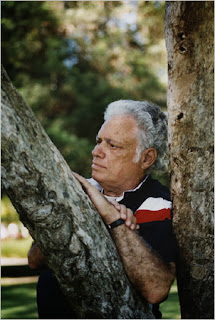The birth of
Bethlehem Records is one of those rather inexplicable moments in the history of jazz. Its founder, Gus Wildi, wasn't particularly interested in jazz, as for instance Norman Granz was. Nevertheless he produced one of the most coherent and significant catalogues in the history of recorded jazz. He gave his musicians and technicians enough freedom in recording which undoubtedly manifest itself on what we hear on the records today.
Bethlehem was also the house of stylist vocalists and, in a rare instance, the house of the bass, an instrument which was hardly the feature instrument of jazz combos. It's a fact that some of the best early small combo sessions led by bassists were recorded by the label, among which albums with Oscar Pettiford, Milt Hinton, Charles Mingus and Red Mitchell stand out. This is of course way before the arrival of experimental labels such as ECM and one should raise hat to the sheer audacity of the Bethlehem owner whose projects turned out to be a financially ruinous one.
The company originally started in 1953 as a pop music venture, but the failure in promoting its records forced Wildi to retreat to the less competitive field of jazz. They released thirty eight 10-inch LP records and then in 1955 changed over to 12-inch format. Bethlehem enjoyed presenting many great names in their catalogue, none of whom had a long term contract with the label which in the process made it difficult for the financial survival of the label. In 1962, the company was sold to King Records whose owners didn't care much for Bethlehem's back-catalogue and because of that, for years the Bethlehem jazz albums remained scarce items to get hold of.
What I've gathered here is the cover artworks of the 1000 series which was released on 10-inch LPs. The number ends in 40, but in reality only 38 records were released and numbers 38 and 39 were never issued.
 |
| © Katherine Holzman |
What is so fascinating about these covers is their design, mostly the result of the relentless creativity of Burt Goldblatt [pic on the right] whose graphic concepts helped to revolutionize the jazz covers of the 50s.
On why Goldblatt was hired by the company, Wildi told
Tyler Alpern:
"We recognized from our first 10 inch album release on, that the importance of the quality of the cover was underrated by the other companies. I believe then that Bethlehem was the first company to create covers with some artistic merit as opposed to use them akin to soap or soup advertisements. The covers were heavily laminated, wrapped around, and minimal type was used, giving off a feeling of quality and substance."
Burt Goldblatt used photography, painting and drawing to achieve certain graphic effects that he was aiming for, supporting the moods that were evoked by listening to the album itself and even being present at the recording session with his Hasselblad camera. His visual motives and themes were deserted streets, instruments in still life compositions, ultra-large colour typefaces, noirish images, low-angle shots, nature, solitude and animals with a special attention to the owls. He also "eliminated long lists of song titles, one of the medium’s more obtrusive conventions," as he told the New York Time.
Goldblatt was constantly innovative and bound to try new methods of creating character for the record, as for Charlie Mariano Sextet he X-rayed a saxophone and used it for the cover art.
This gallery, in order of release, is only composed of 1000 series (10'' LP). Some of them are from the UK editions, released by London Records, but the cover artwork is the same as the original US release.


